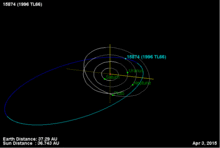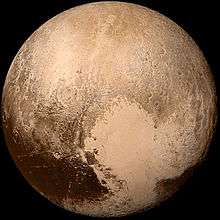(15874) 1996 TL66
| Discovery[1] | |
|---|---|
| Discovered by |
David C. Jewitt Jane X. Luu Jun Chen C. A. Trujillo |
| Discovery date | 9 October 1996 |
| Designations | |
| MPC designation | (15874) 1996 TL66 |
| none | |
| Scattered disc[2][3] | |
| Orbital characteristics[4] | |
| Epoch 13 January 2016 (JD 2457400.5) | |
| Uncertainty parameter 2 | |
| Observation arc | 5883 days (16.11 yr) |
| Aphelion | 131.75 AU (19.710 Tm) |
| Perihelion | 35.057 AU (5.2445 Tm) |
| 83.403 AU (12.4769 Tm) | |
| Eccentricity | 0.57967 |
| 761.70 yr (278211 d) | |
Average orbital speed | 2.98 km/s |
| 6.8505° | |
| 0° 0m 4.658s / day | |
| Inclination | 24.006° |
| 217.82° | |
| 184.79° | |
| Earth MOID | 34.0647 AU (5.09601 Tm) |
| Jupiter MOID | 30.0743 AU (4.49905 Tm) |
| Physical characteristics | |
| Dimensions |
339±20 km[5] ≈ 575±115 km[6] |
| 12 h (0.50 d) | |
|
0.110+0.021 −0.015 [5] 0.035+0.02 −0.01 [6] | |
| Temperature | ≈ 31 K |
| 21[7] | |
| 5.4[4] | |
|
| |
(15874) 1996 TL66 (also written (15874) 1996 TL66) is a trans-Neptunian object (TNO) that resides in the scattered disc. The Spitzer Space Telescope has estimated this object to be about 575 kilometres (357 mi) in diameter,[6] but 2012 estimates from the Herschel Space Observatory estimate the diameter as closer to 339 kilometres (211 mi).[5] It is not a detached object, since its perihelion (closest approach to the Sun) is under the influence of Neptune.[3] Light-curve-amplitude analysis suggests that it is a spheroid.[8] Tancredi presents "in the form of a decision tree, the set of questions to be considered in order to classify an object as an icy 'dwarf planet'." They find that (15874) 1996 TL66 is very probably a dwarf planet.[9] Mike Brown's website, using a radiometrically determined diameter of 344 kilometres (214 mi), lists it as a possible dwarf planet.[10]
Discovery
Discovered in 1996 by David C. Jewitt et al., it was the first object to be categorized as a scattered-disk object (SDO), although (48639) 1995 TL8, discovered a year earlier, was later recognised as a scattered-disk object. It was one of the largest known trans-Neptunian objects at the time of the discovery. It came to perihelion in 2001.[4]
Orbit and size

(15874) 1996 TL66 orbits the Sun with a semi-major axis of 83.9 AU[4] but is currently only 35 AU from the Sun with an apparent magnitude of 21.[7] In 2007, the Spitzer Space Telescope estimated it to have a low albedo with a diameter of about 575±115 km.[6] More-recent measurements in 2012 by the 'TNOs are Cool' research project and reanalysis of older data have resulted in a new estimate of these figures.[5] It is now assumed that it has a higher albedo and the diameter was revised downward to 339±20 km. Light-curve-amplitude analysis shows only small deviations, suggesting (15874) 1996 TL66 is a spheroid with small albedo spots and may be a dwarf planet.[8]
References
- ↑ "MPEC 1997-B18: 1996 TL66". Minor Planet Center. 1997-01-30. Retrieved 2011-07-05.
- ↑ "List Of Centaurs and Scattered-Disk Objects". Minor Planet Center. Retrieved 2009-01-22.
- 1 2 Marc W. Buie (2006-07-30). "Orbit Fit and Astrometric record for 15874". SwRI (Space Science Department). Retrieved 2009-01-22.
- 1 2 3 4 "JPL Small-Body Database Browser: 15874 (1996 TL66)" (2006-07-30 last obs). Retrieved 5 April 2016.
- 1 2 3 4 Santos-Sanz, P., Lellouch, E., Fornasier, S., Kiss, C., Pal, A., Müller, T. G., Vilenius, E., Stansberry, J., Mommert, M., Delsanti, A., Mueller, M., Peixinho, N., Henry, F., Ortiz, J. L., Thirouin, A., Protopapa, S., Duffard, R., Szalai, N., Lim, T., Ejeta, C., Hartogh, P., Harris, A. W., & Rengel, M. (2012). “TNOs are Cool”: A Survey of the Transneptunian Region IV - Size/albedo characterization of 15 scattered disk and detached objects observed with Herschel Space Observatory-PACS
- 1 2 3 4 John Stansberry; Will Grundy; Mike Brown; Dale Cruikshank; John Spencer; David Trilling; et al. (2007). "Physical Properties of Kuiper Belt and Centaur Objects: Constraints from Spitzer Space Telescope". arXiv:astro-ph/0702538
 [astro-ph].
[astro-ph]. - 1 2 "AstDys (15874) 1996TL66 Ephemerides". Department of Mathematics, University of Pisa, Italy. Retrieved 2010-02-10.
- 1 2 Tancredi, G., & Favre, S. (2008) Which are the dwarfs in the Solar System?. Depto. Astronomía, Fac. Ciencias, Montevideo, Uruguay; Observatorio Astronómico Los Molinos, MEC, Uruguay. Retrieved 10-08-2011
- ↑ Tancredi, G. (2010). "Physical and dynamical characteristics of icy "dwarf planets" (plutoids)". Icy Bodies of the Solar System: Proceedings IAU Symposium No. 263, 2009.
- ↑ Michael E. Brown. "How many dwarf planets are there in the outer solar system? (updates daily)". California Institute of Technology. Archived from the original on 2011-10-18. Retrieved 2014-06-16.
External links
- Orbital simulation from JPL (Java) / Horizons Ephemeris
- 1996 TL66: A New Type of Transneptunian Object – MPC news release
- 1996 TL66, a Newly Discovered Planetesimal
- 1996 TL66 – A New Dynamical Class in the Outer Solar System – from David Jewitt's Kuiper Belt website
- Lists and Plots: Minor Planets
- (15874) 1996 TL66 at the JPL Small-Body Database
_(cropped).jpg)
